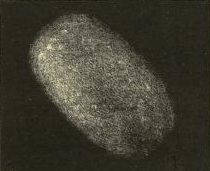astro.wikisort.org - Comet
5D/Brorsen (also known as Brorsen's Comet or Comet Brorsen) was a periodic Jupiter-family comet discovered on February 26, 1846, by Danish astronomer Theodor Brorsen. The perihelion of 5D/Brorsen was February 25, just a day before its discovery, and it passed closest to Earth on March 27, at a distance of 0.52 AU.[1] As a result of this close encounter to Earth the comet's coma diameter increased. Johann Friedrich Julius Schmidt estimated it as 3 to 4 arcminutes across on March 9, and 8 to 10 arcminutes across on the 22nd of that same month.[1] On April 22, it was about 20 degrees from the north celestial pole. By the end of this first apparition the orbital period was calculated as 5.5 years.[1] It was discovered that a close approach to Jupiter in 1842 put it in its discovery orbit.[1]
 Coma of 5D/Brorsen, as it appeared on May 14, 1868, drawn by Karl Christian Bruhns | |
| Discovery | |
|---|---|
| Discovered by | Theodor Brorsen |
| Discovery date | 26 February 1846 |
| Alternative designations | 1846 III; P/1846 D2; 1857 II; P/1857 F1; 1868 I; 1873 VI; 1879 I |
| Orbital characteristics A | |
| Epoch | March 31, 1879 |
| Aphelion | 5.610 AU |
| Perihelion | 0.5898 AU |
| Semi-major axis | 3.100 AU |
| Eccentricity | 0.8098 |
| Orbital period | 5.461 a |
| Inclination | 29.382° |
| TJupiter | 2.467 |
| Last perihelion | March 31, 1879[1] |
| Next perihelion | Lost since 1879 |
The comet's 5.5-year period would mean that apparitions would alternate between good and poor.[1] As expected, the comet was missed in its 1851 apparition, when it only came as close as 1.5 AU to Earth.
The comet's orbit was still relatively uncertain, made worse by its approach to Jupiter in 1854. Karl Christian Bruhns found a comet on 18 March 1857.[1] Soon an orbit was computed and it was found to be 5D/Brorsen, although predictions were three months off.[1] The comet was followed until June 1857, and the orbit was then well established.[1] Observers reported that the comet had a bright, almost star-like nucleus.[2]
The comet was missed in 1862, and the next recovery was in 1868. A close approach to Jupiter shortened the period enough to make the comet visible in 1873.[1] A very favorable apparition followed in 1879, allowing the comet to be observed for the longest time to date – four months.[1] The comet was missed in 1884, due to observing circumstances, but was also missed in 1890, a favorable apparition. The next favorable apparition occurred in 1901, but searches did not locate the comet.
The next serious search was started by Brian G. Marsden in 1963, who believed the comet had faded out of existence, but computed the orbit for a very favorable 1973 apparition.[1] Japanese observers made intensive searches for the comet, but nothing turned up. This failure to locate the comet, in conjunction with earlier attempts, lead Marsden to conclude that the comet was lost.[1]
References
- Kronk, Gary W. (2001–2005). "5D/Brorsen". Retrieved 26 December 2005. (Cometography Home Page)
- Gould, B. A. (April 1857). "Second comet of 1857". The Astronomical Journal. 5: 48. Bibcode:1857AJ......5...48G. doi:10.1086/100581.
- ^ Orbital data taken from this preprint: Neslusan, Lubos: "The identification of asteroid 1996 SK with the extinct nucleus of comet 5D/Brorsen", Memorie della Società Astronomica Italiana, Spec. Vol.: Proc. Internat. Conf. held at Palermo, Italy, June 11–16, 2001 (Postscript version)
External links
На других языках
[de] 5D/Brorsen
5D/Brorsen (auch bekannt als Brorsens Komet oder Komet Brorsen) ist ein Komet, welcher von dem dänischen Astronomen Theodor Brorsen am 26. Februar 1856 entdeckt wurde.- [en] 5D/Brorsen
[ru] 5D/Брорзена
Комета Брорзена (5D/Brorsen) — короткопериодическая комета из семейства Юпитера, которая была открыта 26 февраля 1846 года датским астрономом Теодором Брорзеном вблизи звезды η созвездии Рыб. Комета обладает довольно коротким периодом обращения вокруг Солнца — чуть более 6,46 года.Другой контент может иметь иную лицензию. Перед использованием материалов сайта WikiSort.org внимательно изучите правила лицензирования конкретных элементов наполнения сайта.
WikiSort.org - проект по пересортировке и дополнению контента Википедии

